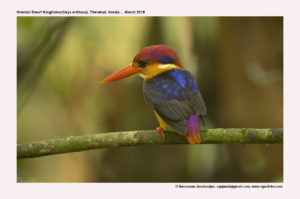Oriental Dwarf Kingfisher

Oriental Dwarf Kingfisher Ceyx erithaca
Etymology:
- Ceyx : Greek mythology Ceyx was drowned at sea and he and his wife Alcyone were metamorphosed into kingfishers when she found his body washed up on the shore
- Erithaca : Small Kingfisher from Bengal
Vernacular Names: Ta: Chinna meenkotti, Mal: Meni ponman, Sinh: Rang pilihuduwa, Hindi: Bauna Kilkila, Mar: Thiboti Khandya/ Dhivar
Distribution in India: Resident of South Western India and summer visitor to East Himalayan foothills and North East India.
Description: Size of 12·5–14 cm; wt. of male is 14–21·5 g, Wt. of female is 14–16 g. Both sexes of nominate race have black spot on forehead, blue and white patch on side of neck, lilac-rufous crown, rump and tail, are dark blue back and wings; chin and throat are white, rest of underparts are pale orange; iris is dark brown; bill, legs and feet are red. Rufous-backed morph similar, but blue-black areas are rufous to violet-rufous. The juvenile is duller, with less lilac, chin, throat and belly white, bill yellow-orange with pale tip; black-backed morph blue only on scapulars and wing-coverts. Race motleyi is like nominate but with stronger lilac tones in both forms. Race macrocarus has darker crown, black frontal spot is absent.
Habitat:It is found in deciduous and evergreen primary and secondary forest, alluvial forest, mangroves, overgrown rubber gardens, thickets of palms, bamboo or shrubs in forest, near streams and ponds. They are found from lowlands up to 1300 m.
Food habits: It eats insects, like mantises, grasshoppers, flies, water beetles, winged ants, mayflies, spiders, worms, small crabs, fishes and frogs and lizards. It perches low in vegetation or on rocks; flies out to take prey from the ground or from among foliage. It takes spiders in their webs or insects in flight; dives into water without submerging for prey at or just below the surface. The larger prey are brought back to a perch, where struck repeatedly before being swallowed.
Breeding habits: They breed in Jul–Sept in South West India, in Feb–Jul in Sri Lanka, in Apr–May in North East India, in Mar–Jul in Peninsular Malaysia, in Mar in Sumatra and in Dec–May in Java. The nest is a tunnel in the soft ground. They nest in stream bank or road cutting, or in terrestrial termitarium, or in soil in roots of a fallen tree, often well away from water. Both of pair excavate tunnel in sandy soil. They lay a clutch of 3–7 eggs.